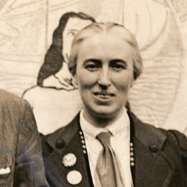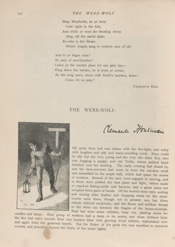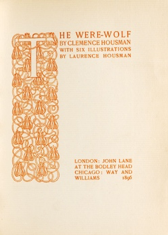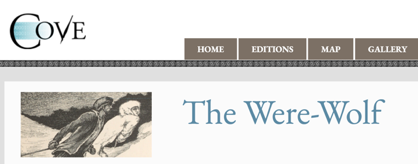Textual History and Contemporary Reception of Clemence Housman’s The Were-Wolf
Clemence Housman mediated and remediated The Were-Wolf, her gothic novella, for a variety of audiences over a span of forty years (see Timeline). Given this continued intervention, it is worth examining how this little-studied novel evolved—how the story came into being, where it was published, and the criticism it received—as this provides greater context for the nuances in narrative and meanings that the text has and continues to produce.
 Figure 1. Cropped newspaper image of Clemence Housman circa 1910. Wikimedia Commons
Figure 1. Cropped newspaper image of Clemence Housman circa 1910. Wikimedia Commons
Clemence Annie Housman (1861-1955) was an author, wood engraver, and activist in the women’s suffrage movement. A feminist with a fierce commitment to independence and gender parity while also being a strong believer in sacrifice and redemption, Clemence Housman infused The Were-Wolf with the conflict she herself experienced in her life and work. Housman’s titular character, the werewolf White Fell, embodies these conflicts and dichotomies. As Melissa Purdue notes, the hybrid “werewolf identity mirrors the rupture that results from trying to embody 'conflicting' roles, and it emphasizes White Fell’s inability to conform to societal expectations for women” (43).
The Oral Tale (1884)
Clemence was given permission to go to London with her younger brother Laurence when he moved to the metropolis to study art. Although this was contrary to Victorian expectations of women’s place being the home, Laurence needed someone reasonable and sensible to take care of him while living in the city. According to Laurence himself, he was not seen as “stable” enough to go on his own (Unexpected Years 91). While her brother was studying art, Clemence began studying wood-engraving, an uncommon topic of study and form of employment for women at the time (Kooistra, “Clemence Housman’s The Were-Wolf 5). Laurence was supportive of Clemence’s education and independence, and writes that they chose to live in Kennington specifically to be near the City and Guilds South London Technical Art School, an arts and crafts school that included wood-engraving as a subject (94).
Clemence wrote The Were-Wolf for the entertainment and pleasure of the female students in her wood-engraving class at City and Guilds South London Technical Art School in 1884 (L. Housman, Unexpected Years 97). According to Laurence, her audience was “thrilled by its horror” (Kooistra, “Clemence Housman’s The Were-Wolf” 6). However, Clemence went beyond mere entertainment to also implicitly comment on the problematic environment that she, and the other women wood-engravers of the fin-de-siècle, were forced to operate within.
The gender divided structure of Clemence’s wood-engraving classes at the South London art school, along with her later employment as a woman wood-engraver, significantly shaped the story of The Were-Wolf. By opening The Were-Wolf with a scene where both men and women, unsegregated by gender, are completing artisanal crafts in a communal farm hall (1), Clemence critiques gender-segregated wood-engraving classes and work by offering an alternative to the status quo. Gender-segregated classes essentially resulted in unequal training between men and women, with women receiving poorer training (C. Housman, “Wood-Engraving” 3 ). This example supports interpretations of The Were-Wolf as a story written to amuse as well as to provide social and cultural commentary on feminist issues.
The Magazine Story (1890)
 Figure 2. First page of “The Were-Wolf” as a Christmas story in Atalanta: A Magazine for Girls (1890). Public Domain
Figure 2. First page of “The Were-Wolf” as a Christmas story in Atalanta: A Magazine for Girls (1890). Public Domain
Clemence and Laurence decided that her Gothic tale featuring a strange and fearless woman werewolf was “too good to be kept only for private circulation” (L. Housman, Unexpected Years 97). Together they submitted The Were-Wolf to Alfred William (A.W.) Pollard (1859-1944), an English bibliographer and family friend, for his opinion. Though Pollard was not affiliated with the magazine, Pollard’s endorsement of The Were-Wolf resulted in its publication in the 1890 Christmas number of the Atalanta magazine. Under the editorship of L.T. Meade (1844-1914), who was also a writer of girls’ stories, the Atalanta magazine was a monthly “ambitious, advanced periodical for girls and young women” promoting both female education and employment (Mitchell n. pag.). As Purdue notes, Clemence Housman’s feminist activism and her selection of publication venue are not coincidental to her story or purpose (44). It is interesting then that Clemence, who was also a promoter of both female education and employment, was not treated fairly by the Atalanta publication team.
Despite the great commercial success of the 1890 Christmas number of Atalanta, Clemence was paid unfairly for her work (L. Housman, Unexpected Years 97). Upon discovering that Clemence was not a professional author, the Atalanta publishers paid a sum of £5 for the tale, which was not appropriate for a story of The Were-Wolf's length (L. Housman, "Materials and Notes"). The editorial team at Atalanta had been “struck by the quality” of The Were-Wolf and wanted Clemence to publish future works with them and so Clemence, Laurence, and Pollard had a difficult time accepting the low payment that had been offered for the story. Pollard forcefully protested on Clemence’s behalf and was able to negotiate a more adequate payment for her contribution to the magazine (Unexpected Years 98). In the long run, publication of The Were-Wolf in the
Atalanta magazine brought Clemence’s story, which had only been orally circulated up until this point, out of her wood-engraving class, and opened it up to “New Woman” readers.
The Illustrated Book (1896)
 Figure 3. Title-page of The Were-Wolf published by John Lane at The Bodley Head (1896)
Figure 3. Title-page of The Were-Wolf published by John Lane at The Bodley Head (1896)
Laurence was introduced to John Lane (1854-1925) when Aubrey Beardsley (1872-1898), well-known aesthetic author and illustrator, asked him to do a drawing for The Yellow Book (1894-1897), a controversial avant-garde illustrated periodical published by Lane’s firm, The Bodley Head (Unexpected Years 103). Laurence did a great deal of illustration and book design work for The Bodley Head during the 1890s. Their established professional relationship provided Laurence with an entry point for submitting The Were-Wolf for book publication through Lane in 1896. While the Atalanta (1890) version was illustrated by Everard Hopkins (1860-1928) (Engen, Victorian Wood Engravers 125), the Bodley Head publication provided the opportunity for the siblings to combine their talents. This edition is a collaboration between Clemence, who wrote the story and engraved the illustrations on woodblocks, and Laurence, who designed all the illustrative and decorative elements.
The Bodley Head publication introduced The Were-Wolf to the new bold and opinionated lower-middle class readers created by the Education Act of 1870, as well as aesthetes and other book lovers who bought and appreciated Lane’s selection of books in belles lettres (Stetz and Lasner viii). The edition was well-received by critics, with one reviewer describing it as “half fairy tale, half allegory, and displaying qualities of imagination and invention that are hard to seek in any other recent book of the kind that I have come across” (“Our Monthly Parcel” 92). Another reviewer praised Clemence’s writing ability, stating that “Miss Housman has succeeded where the attempts are numerous to-day and the failures very many. She has re-told an old legend, or rather summarized many legends, has made additions of her own, told it so as to pick out from it a modern meaning, and yet has enfeebled it not at all. Her success is very rare” (Rev. in The Bookman 162).
The Digital Edition (2018)
 Figure 4. Screenshot of the Header for the Cove Edition of The Were-Wolf (2018)
Figure 4. Screenshot of the Header for the Cove Edition of The Were-Wolf (2018)
Undoubtedly, The Were-Wolf has had a rich textual history. Clemence’s repeated telling of her gothic tale for various audiences over her lifetime suggests that the subject of her first novel continued to fascinate her. The COVE digital edition aims to make the collaborative edition produced by the two Housman siblings available for an even wider audience in the 21st century.
Harpreet Kaur Natt, Ryerson University, 2018
Citation: Natt, Harpreet Kaur. "Textual History and Contemporary Reception of Clemence Housman's The Were-Wolf.” Clemence Housman's The Were-Wolf, edited by Lorraine Janzen Kooistra, Harprett Kaur Natt, et al, COVE Editions, 2018. https://editions.covecollective.org/edition/were-wolf/textual-history-and-contemporary-reception-clemence-housman%E2%80%99s-were-wolf.
Works Cited
Engen, Rodney. Dictionary of Victorian Wood Engravers, Cambridge, 1985.
Housman, Clemence. The Were-Wolf. Illustrated by Everard Hopkins. Atalanta vol. 4, no. 39, Dec. 1890, pp. 132-56.
---. The Were-Wolf. With 6 illustrations by Laurence Housman engraved by Clemence Housman. London: John Lane at the Bodley Head, 1896.
[Housman, Clemence]. “Wood Engraving.” Occupations for Women Other Than Teaching. London: Association for Assistant-Mistresses, 1887, pp. 3-5. Pamphlet in Mark Samuels Lasner’s Laurence Housman collection, 62.1, University of Delaware Library.
Housman, Laurence. Materials and Notes for Autobiographical Account in the Laurence Housman Papers, Bryn Mawr College Library Special Collections.
---. The Unexpected Years. Bobbs-Merrill, 1936.
Kooistra, Lorraine Janzen. “Clemence Housman’s The Were-Wolf: Querying Transgression, Seeking Trans/Formation.” Forthcoming in Victorian Review 2018.
Mitchell, Sally. “Atalanta (1887-1898).” Dictionary of Nineteenth Century Journalism, edited by Laurel Brake and Marysa Demoor, C19 Index ProQuest, http://gateway.proquest.com/openurl?url_ver=Z39.88-2004&res_dat=xri:c19index-us&rf_dat=xri:c19index:DNCJ:57
Oakley, Elizabeth. Inseparable Siblings: A Portrait of Clemence & Laurence Housman. Brewin Books, 2009.
“Our Monthly Parcel of Books.” Review of The Were-Wolf, by Clemence Housman. Review of Reviews, vol. 13, January 1896, pp. 90-92.
Purdue, Melissa. “Clemence Housman’s The Were-Wolf: A Cautionary Tale for the Progessive New Woman.” Revenant vol. 2, 2016, pp. 43-55.
Stetz, Margaret D., and Mark Samuels Lasner. England in the 1890s: Literary Publishing at the Bodley Head. Georgetown University, 1990.
Review of The Were-Wolf, by Clemence Housman. The Bookman, February 1896, p. 162. ProQuest.
